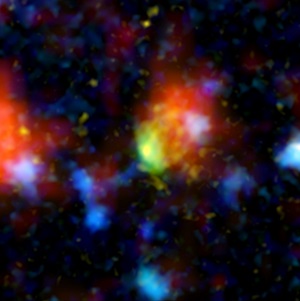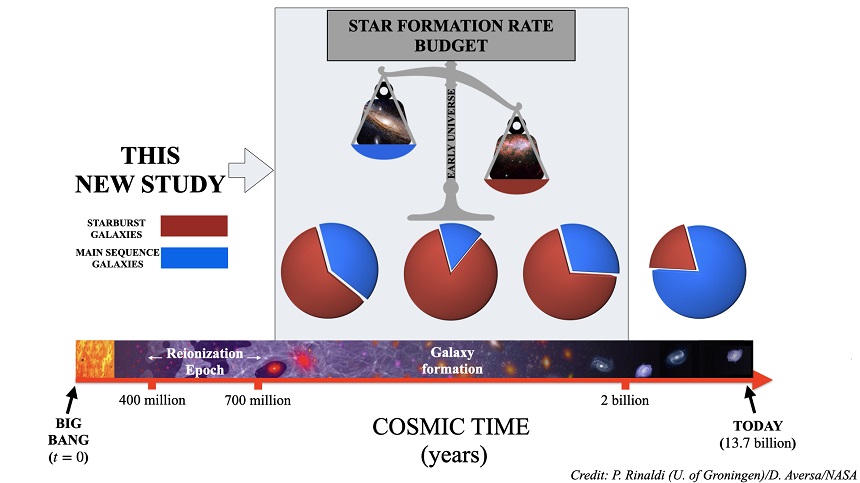Vroeg heelal wemelde van sterrenstelsels met groeispurt
Het heelal bevatte de eerste paar miljard jaar na de oerknal veel meer zogeheten startburststelsels dan de modellen voorspellen. Maar liefst 60 tot 90 procent van de sterren blijkt in het vroege heelal geproduceerd te zijn door sterrenstelsels die een groeispurt ondergaan. Dat toont een door Groningse astronomen geleide analyse van meer dan 20.000 verre sterrenstelsels. Het team publiceert de bevindingen binnenkort in The Astrophysical Journal.
Starburststelsels zijn sterrenstelsels in een groeispurt. Ze produceren in relatief korte tijd veel meer sterren dan normaal. Een stellaire groeispurt duurt 10 tot 100 miljoen jaar. Sterrenstelsels leven vaak miljarden jaren en kunnen meerdere groeispurts ondergaan. Om een groeispurt op gang te brengen, moet er een plotselinge toevloed van gas plaatsvinden, want anders raken de bouwstenen voor nieuwe sterren snel op. Zo'n toevloed van gas kan bijvoorbeeld ontstaan als twee sterrenstelsels dicht bij elkaar in de buurt komen.
Een onderzoeksteam onder leiding van Pierluigi Rinaldi, promovendus aan de Rijksuniversiteit Groningen, bestudeerde de gegevens van meer dan 20.000 verre sterrenstelsels. Deze gegevens zijn de afgelopen jaren verzameld met de Ruimtetelescoop Hubble, met het MUSE-instrument op de Europese Very Large Telescope in Chili en met de Spitzer Space Telescope. De telescopen keken zo ver terug in de tijd dat de onderzoekers sterrenstelsels konden bestuderen die 11 tot 13 miljard jaar geleden zijn ontstaan. De oerknal was 13,7 miljard jaar geleden.
Uit de analyse blijkt dat in de eerste paar miljard jaar na de oerknal zo'n 20 tot 40 procent van alle stervormende sterrenstelsels uit starburststelsels bestaat. Die sterrenstelsels in groeispurt zorgden voor 60 tot 90 procent van de nieuwe aanwas van sterren. Ter vergelijking, nu is het heelal een stuk rustiger en ontstaat maar zo'n 10 procent van de nieuwe sterren in starburststelsels.

Babytijd
De analyse laat verder zien dat groeispurts bij kleinere sterrenstelsels vaker voorkomen dan bij grotere stelsels. Het lijkt er zelfs op dat veel kleine starburtststelsels door de telescopen zijn vastgelegd juist op het moment dat ze zich aan het vormen zijn. "In die zin kun je het wel wat vergelijken met de groeispurt bij de mens. Die is ook het sterkst in de babytijd", zegt Rinaldi.
De resultaten kwamen als een verrassing omdat starburststelsels tot voor kort als ongewoon en van ondergeschikt belang werden beschouwd voor het ontstaan en groeien van sterrenstelsels. "Zelfs de nieuwste en meest verfijnde modellen voor de vorming van sterrenstelsels hadden dit niet voorspeld", aldus Rinaldi. "Waarschijnlijk spelen de natuurkundige processen die de stervorming aandrijven op een te kleine schaal voor de modellen."
Karina Caputi (Rijksuniversiteit Groningen), begeleider van Rinaldi voegt toe: "Dat geeft natuurlijk wel wat te denken over die modellen. En dat komt goed uit." De komende tijd wil Caputi namelijk de oorsprong en evolutie van de eerste sterrenstelsels nader onderzoeken. Dat kan mede doordat ze onlangs een Vici-beurs van NWO ontving en doordat de James Webb-ruimtetelescoop ook zijn spiegels gaat richten op verre sterrenstelsels.
Wetenschappelijk artikel
The galaxy starburst/main-sequence bimodality over five decades in stellar mass at z ~ 3-6.5. Door: Pierluigi Rinaldi (1), Karina I. Caputi (1,2), Sophie E. van Mierlo (1), Matthew L. N. Ashby (3), Gabriel B. Caminha (4,1) & Edoardo Iani (1). Geaccepteerd voor publicatie in The Astrophysical Journal.
Preprint: https://arxiv.org/abs/2112.03935
1. Kapteyn Instituut, Rijksuniversiteit Groningen
2. Cosmic Dawn Center (DAWN), Denemarken
3. Harvard Smithsonian Center for Astrophysics, Cambridge, Massachusetts, Verenigde Staten
4. Max-Planck-Institut für Astrophysik, Garching, Duitsland
Bron: NOVA/Astronomie.nl

